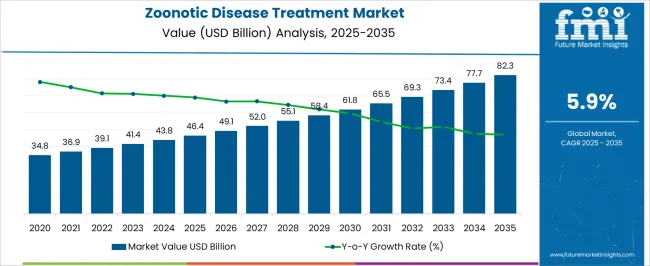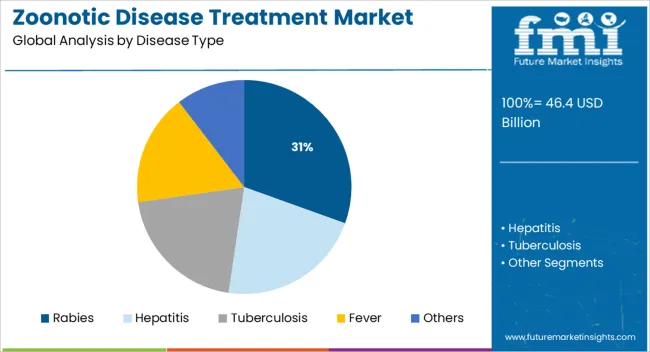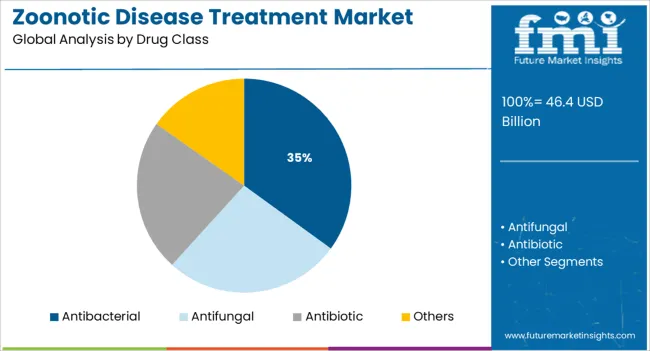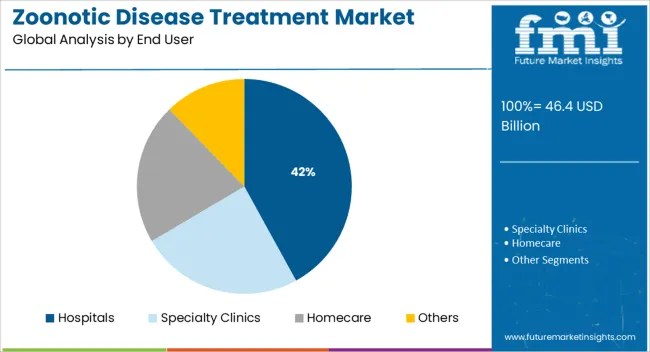The Zoonotic Disease Treatment Market is estimated to be valued at USD 46.4 billion in 2025 and is projected to reach USD 82.3 billion by 2035, registering a compound annual growth rate (CAGR) of 5.9% over the forecast period.

| Metric | Value |
|---|---|
| Zoonotic Disease Treatment Market Estimated Value in (2025 E) | USD 46.4 billion |
| Zoonotic Disease Treatment Market Forecast Value in (2035 F) | USD 82.3 billion |
| Forecast CAGR (2025 to 2035) | 5.9% |
The zoonotic disease treatment market is advancing steadily as public health concerns related to animal-to-human infections intensify globally. Increased prevalence of zoonotic diseases alongside rising awareness about early diagnosis and effective treatment is fueling demand for specialized therapies.
Healthcare providers and governments are prioritizing investments in disease control infrastructure and pharmaceutical interventions to curb outbreaks and reduce mortality rates. Innovations in drug development and enhanced surveillance systems have facilitated timely treatment protocols, while integrated efforts between veterinary and human health sectors are strengthening overall response mechanisms.
Looking ahead, growing emphasis on pandemic preparedness, improved diagnostic capabilities, and expanded healthcare access are expected to create sustained growth opportunities. The market’s trajectory is being shaped by the critical need to manage zoonotic infections effectively and prevent spillover events.
The market is segmented by Disease Type, Drug Class, and End User and region. By Disease Type, the market is divided into Rabies, Hepatitis, Tuberculosis, Fever, and Others. In terms of Drug Class, the market is classified into Antibacterial, Antifungal, Antibiotic, and Others. Based on End User, the market is segmented into Hospitals, Specialty Clinics, Homecare, and Others. Regionally, the market is classified into North America, Latin America, Western Europe, Eastern Europe, Balkan & Baltic Countries, Russia & Belarus, Central Asia, East Asia, South Asia & Pacific, and the Middle East & Africa.

When segmented by disease type, rabies is projected to lead the market with a 30.5% revenue share in 2025. This leadership is driven by the disease’s high fatality rate and the urgent requirement for effective post-exposure treatments.
Healthcare systems have been increasingly focused on expanding access to rabies vaccines and immunoglobulins to prevent disease progression following animal bites. Public health campaigns and government immunization programs have elevated awareness, contributing to increased diagnosis and treatment rates.
Additionally, the need for prophylactic treatment in high-risk populations has reinforced the importance of rabies management as a priority within the zoonotic disease treatment landscape. These factors have collectively established rabies as a key focus area, sustaining its significant market share.

Segmented by drug class, antibacterial treatments are expected to hold a dominant 35.0% share of the market revenue in 2025. The prominence of antibacterials is linked to their broad-spectrum efficacy against numerous bacterial zoonoses, which are commonly encountered in clinical settings.
The widespread use of antibacterial agents for treating infections such as leptospirosis, plague, and brucellosis has driven demand. Furthermore, investments in developing novel antibacterial formulations and combination therapies have supported sustained growth in this segment.
Hospitals and clinics have prioritized antibacterials due to their proven effectiveness, well-established treatment guidelines, and availability. This continued reliance on antibacterial drugs has reinforced their leading position within the treatment market.

When segmented by end user, hospitals are expected to account for a leading 42.0% revenue share in 2025. The dominance of hospitals is attributed to their central role in diagnosing and treating zoonotic diseases, often requiring complex clinical management and inpatient care.
Hospitals have invested significantly in specialized infectious disease units and advanced diagnostic technologies to support early detection and timely intervention. The presence of trained healthcare professionals and infrastructure for administering treatments such as intravenous therapies and vaccinations further cements hospitals as the primary setting for zoonotic disease management.
This segment’s leadership reflects the critical nature of hospital-based care in improving patient outcomes and controlling disease spread.
Population growth, migration, and rapid urbanization are all factors that could lead to the emergence of new zoonotic diseases in the future. Due to market and production procedures for live food animals, people in urban regions are less familiar with dealing with animals than those in rural settings. The urban population may also reside in overcrowded conditions that aid in the spread of disease.
Increased demand for animal proteins is probably going to result in increased consumption of animal fats, which is going to fuel the market for zoonotic disease treatment. With millions of households owning one or more pets for companionship and entertainment. However, the possibility that some animals may carry pathogens that might infect humans when in contact is anticipated to drive the market for the same.
The zoonotic disease treatment market is broadly divided into seven major regions, North America, Latin America, Europe, East Asia, South Asia, Oceania, and the Middle East and Africa.
North America is the leading region in the global zoonotic disease treatment market owing to the rising population, higher rate of immigration, and rapid urbanization.
Apart from North America, the European zoonotic disease treatment market is also expected to display lucrative growth in the projected years due to the extensive livestock farming and increased consumption of animal fat in country places.
The East Asian region is predicted to show lucrative growth owing to a lack of access to safe drinking water and adequate sanitation services, which could contribute to the development of zoonotic diseases.
Cadila Healthcare Ltd, AstraZeneca plc, F. Hoffmann-La Roche AG, GlaxoSmithKline plc, Johnson, Pfizer Inc., Novartis International AG, Sanofi S.A., BioCryst Pharmaceuticals, Inc, Sun Pharmaceuticals Industries, Ltd.
| Report Attributes | Details |
|---|---|
| Growth Rate | CAGR of 5.9% from 2025 to 2035 |
| Base Year for Estimation | 2024 |
| Historical Data | 2012 to 2024 |
| Forecast Period | 2025 to 2035 |
| Qualitative Units | Revenue in USD Billion, and CAGR from 2025 to 2035 |
| Report Coverage | Revenue Forecast, Company Ranking, Competitive Landscape, Growth Factors, and Trends |
| Segment Covered | Disease Type, Drug Class, End User, Region |
| Region Covered | North America; Latin America; Europe; East Asia; South Asia; Oceania; Middle East Africa (MEA) |
| Key Countries Profiled | The USA, Canada, Brazil, Mexico, Germany, The UK, France, Spain, Italy, China, Japan, South Korea, Malaysia, Singapore, Australia, New Zealand, GCC, South Africa, Israel |
| Key Players | Cadila Healthcare Ltd; AstraZeneca plc; F. Hoffmann-La Roche AG; GlaxoSmithKline plc; Johnson Johnson; Pfizer Inc.; Novartis International AG; Sanofi S.A.; BioCryst Pharmaceuticals, Inc; Sun Pharmaceuticals Industries, Ltd. |
| Customization | Available Upon Request |
The global zoonotic disease treatment market is estimated to be valued at USD 46.4 billion in 2025.
The market size for the zoonotic disease treatment market is projected to reach USD 82.3 billion by 2035.
The zoonotic disease treatment market is expected to grow at a 5.9% CAGR between 2025 and 2035.
The key product types in zoonotic disease treatment market are rabies, hepatitis, tuberculosis, fever and others.
In terms of drug class, antibacterial segment to command 35.0% share in the zoonotic disease treatment market in 2025.






Full Research Suite comprises of:
Market outlook & trends analysis
Interviews & case studies
Strategic recommendations
Vendor profiles & capabilities analysis
5-year forecasts
8 regions and 60+ country-level data splits
Market segment data splits
12 months of continuous data updates
DELIVERED AS:
PDF EXCEL ONLINE
Disease Resistant Mask Market Analysis - By Type, Material, End-User, Distribution Channel, and Region - Trends, Growth & Forecast 2025 to 2035
Rare Disease Clinical Trials Market Size and Share Forecast Outlook 2025 to 2035
The lung disease therapeutics market is segmented by disease type, treatment type and distribution channel from 2025 to 2035
Rare Disease Gene Therapy Market
Swine Disease Diagnostic Kit Market Size and Share Forecast Outlook 2025 to 2035
Liver Disease Diagnostics Market Size and Share Forecast Outlook 2025 to 2035
Fabry Disease Market Size and Share Forecast Outlook 2025 to 2035
Byler Disease Market
Celiac Disease Diagnostics Market Analysis - Size, Share & Forecast 2025 to 2035
Airway Disease Treatment Market Size and Share Forecast Outlook 2025 to 2035
Shrimps Disease Diagnostics Market Size and Share Forecast Outlook 2025 to 2035
Chronic Disease Management Market Size and Share Forecast Outlook 2025 to 2035
The Addison Disease Testing Market Is Segmented by Test Type, and End User from 2025 To 2035
Pleural Diseases Therapeutics Market – Drug Trends & Future Outlook 2025 to 2035
Crohn’s Disease (CD) Treatment Market Analysis & Forecast by Drug Type, Distribution Channel and Region through 2035
Sandhoff Disease Therapeutics Market Size and Share Forecast Outlook 2025 to 2035
Wilson’s Disease Diagnostics Market Analysis – Size, Share & Forecast 2023-2033
Infectious Disease Diagnostics Market Size and Share Forecast Outlook 2025 to 2035
Predictive Disease Analytics Market Size and Share Forecast Outlook 2025 to 2035
Autoimmune Disease Therapeutics Market Analysis – Size, Share, & Forecast Outlook 2025 to 2035

Thank you!
You will receive an email from our Business Development Manager. Please be sure to check your SPAM/JUNK folder too.
Chat With
MaRIA